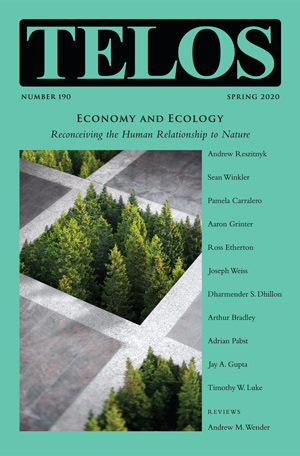Ross Etherton’s “Reading against the Gun: The Machine Gun and Sturm” appears in Telos 190 (Spring 2020): Economy and Ecology: Reconceiving the Human Relationship to Nature. Read the full article at the Telos Online website, or purchase a print copy of the issue in our online store. Individual subscriptions to Telos are available in both print and online formats. Ernst Jünger’s Sturm, published in English translation by Telos Press, is also available in our store.
 This essay examines the role of the machine gun in Ernst Jünger’s 1923 serially published novella Sturm, arguing that an examination of the novella’s key technological actant is at least as beneficial as an examination of the text’s human protagonists. It posits that reading Sturm in light of the machine gun and in the context of the material and cultural conditions of its original serial publication allows for a different understanding of the novella’s treatment of reading and writing under the conditions of modern mechanized warfare. The essay not only links the technical process at the heart of the gun (continuity derived from explosive interruption) to the explosive interruptions within the novella; it also links this interruptive continuity to the arbitrary, irregular breaks in its original serial publication. This technical-literary approach connects the literary scholarship on Sturm (primarily by Peter Uwe Hohendahl and David Pan) with one indebted to philosopher Gilbert Simondon, who sought to redress humanity’s profound alienation from technology and technical objects. The essay first outlines its approach to Sturm, and then provides readers with an overview of Sturm‘s publication history, contextualizing it within Jünger’s early works. It then examines the explosively interruptive moments of the novella, tying them to the machine gun and to nineteenth- and early twentieth-century scientific, philosophical, and poetological discourses. It closes by gesturing toward the importance that the gun and the concepts embedded in it would have for Jünger in the decade following Sturm.
This essay examines the role of the machine gun in Ernst Jünger’s 1923 serially published novella Sturm, arguing that an examination of the novella’s key technological actant is at least as beneficial as an examination of the text’s human protagonists. It posits that reading Sturm in light of the machine gun and in the context of the material and cultural conditions of its original serial publication allows for a different understanding of the novella’s treatment of reading and writing under the conditions of modern mechanized warfare. The essay not only links the technical process at the heart of the gun (continuity derived from explosive interruption) to the explosive interruptions within the novella; it also links this interruptive continuity to the arbitrary, irregular breaks in its original serial publication. This technical-literary approach connects the literary scholarship on Sturm (primarily by Peter Uwe Hohendahl and David Pan) with one indebted to philosopher Gilbert Simondon, who sought to redress humanity’s profound alienation from technology and technical objects. The essay first outlines its approach to Sturm, and then provides readers with an overview of Sturm‘s publication history, contextualizing it within Jünger’s early works. It then examines the explosively interruptive moments of the novella, tying them to the machine gun and to nineteenth- and early twentieth-century scientific, philosophical, and poetological discourses. It closes by gesturing toward the importance that the gun and the concepts embedded in it would have for Jünger in the decade following Sturm.



